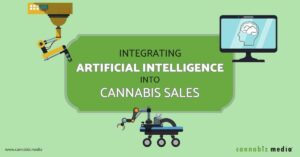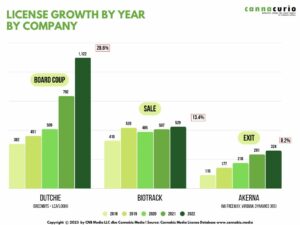
Customer relationship management (CRM) is essential to business success today for a very simple reason. Customers expect businesses to know who they are, understand their wants and needs, personalize communications, and create experiences specifically for them.
Your cannabis or cannabis-related business can’t meet and exceed customer expectations if you don’t know who they are and deliver what they want at the right times. Fortunately, a solid CRM strategy combined with CRM software can help you meet customers’ needs across the entire customer lifecycle – from prospect to loyal repeat customer and vocal brand advocate.
The Secret to Developing a CRM Strategy that Works
Today’s consumers (both B2B and B2C) won’t tolerate irrelevant marketing communications or sales outreach. To develop a CRM strategy for your cannabis business or ancillary business, you need to prioritize the customer above all else.
You can do this by shifting your way of thinking about customer relationships and communications from transaction-centric (a sales-first approach) or brand-centric (a product / service / brand / business-first approach) to customer-centric (a prospect / customer-first approach).
In the customer-centric model, the customer relationship requires considerably more ongoing management. Once-and-done marketing tactics and one-off sales outreach tactics are ineffective when customers expect you to know who they are and what they want. That means generic communications no longer work in a world where customers expect (and demand) personalized communications and brand experiences. In fact, anything generic is likely to send them directly to a competitor who takes the time to know them and deliver on their expectations.
Customer Relationship Management is Not Just CRM Software
For your CRM investments and efforts to drive positive results for your cannabis business or cannabis-related business, there is a very important fundamental that you need to understand. CRM is not just a CRM software tool. CRM encompasses the entire philosophy of putting your customers first and delivering communications and experiences that meet them where they are along the buyer journey.
Therefore, investing in a CRM software platform is just one piece of the puzzle. You also need to change how you think about customer relationships, and you need to understand the buyer journey and how it aligns to your marketing, sales, and customer service experiences.
The CRM software you use will help streamline tasks, save time and money, reduce redundancy, improve collaboration, and more, so you can effectively implement a plan to reach your CRM goals. However, you first need CRM buy-in from leadership, customer-centric trained employees, and a CRM strategy before a CRM tool can help your business. Think strategy before implementation. CRM software aids implementation and helps you track results, but it’s not all there is to CRM.
5 Steps to Create a B2B CRM Strategy
A CRM strategy will help your business improve customer experiences, boost sales, reduce churn, improve team collaboration, save time and money, track prospects and customers, and more. Following are the key steps to create your B2B CRM strategy.
1. Assess Your Readiness and Define Your CRM Goals
Are you and your employees ready to shift to the customer-centric thinking required to get the best returns on a CRM investment, which includes time, training, execution, software, and more? If not, then you need to do some work to prepare for that necessary change in thinking before you can develop a CRM strategy. Education is the key, so do your research and train your team on the importance of a customer-first approach with today’s B2B buyers before you do anything else.
If you’re ready to prioritize customers, then it’s time to define your CRM goals. Remember, these goals aren’t about your CRM software. They’re about outcomes your business will achieve if your business effectively manages customer relationships (CRM software is just a tool to help you do it).
Therefore, consider goals related to closed sales, more qualified leads, more repeat purchases, fewer customer service calls, increased productivity, improved customer satisfaction, and so on. Identify realistically achievable metrics and timeframes for each of these goals (e.g., 20% increase in sales qualified leads from email marketing campaigns by December 31).
2. Define Your Target Audience(s) and Their Customer Journey(s)
If you don’t already have buyer personas created for your ideal customer profile and any other important target audiences, then now is the time to create them. You can’t develop a strong relationship with customers and deliver personalized communications and experiences – the kind they want and expect from your business – if you don’t know who they are. You may even waste time on unqualified leads if you don’t identify your target audience(s) up front.
Understanding who is likely to buy from you and why is essential to customer-centric thinking. If you don’t have buyer personas developed already, get started by studying the data you currently have about your customers and prospects. This includes demographic and behavioral data (e.g., what email campaigns they’ve opened, what products they’ve purchased or viewed on your website, and so on). You can also conduct market research and ask your audience questions to learn more about who they are and what they want or need.
Your work doesn’t end once your buyer personas are developed. You also need to map the customer journey so you can deliver the most personalized and relevant communications and experiences at all times. This information will also determine who is responsible for a lead or customer across the customer lifecycle, so each team (i.e., marketing, sales, and customer service) can review their communications and tactics to ensure they’re as successful as possible.
3. Define Roles and Processes
When does an unqualified lead become a marketing qualified lead? When does a marketing qualified lead become a sales qualified lead? What determines if a prospect is a sales qualified lead or not? These are just some of the questions you need to answer to define the roles and processes needed to reach your CRM goals.
Roles and responsibilities should be defined to reduce redundancies and hold the right people accountable for leads and customers across the entire customer lifecycle (e.g., pre-sales, sales, post-sales). Processes should be written so everyone is on the same page and CRM plans can be executed without questions or challenges.
It’s also critical to educate team members about customer-centric thinking and the philosophy of CRM so they understand why it’s important to the business and how it will help prospects, customers, and themselves. Without employee buy-in, they won’t commit to CRM, and your business’ efforts to manage relationships to drive better business results will fail.
4. Identify Key Performance Indicators to Measure Success
Based on the goals you set for your CRM strategy, what metrics are needed to evaluate your success in achieving those goals? By defining roles and processes in Step 3, you’ll be able to correlate performance metrics to the right team members and the corresponding goals.
For example, goals and metrics could relate to sales deals, customer retention, revenue, profits, customer satisfaction, and more. Tracking things like email marketing campaign open and click rates, customer service inquiries, Net Promoter Score (NPS), closed sales, and sales deal values can help you quantify the success of your CRM strategy and investments.
5. Implement CRM Software and Train Team for Collaboration
CRM software makes the entire process of managing customer relationships easier, less time-consuming, and less costly by streamlining processes, reducing double work, improving team collaboration, and centralizing data, including prospect/customer histories.
For example, when you integrate email marketing and CRM, your team will save time and have access to all of the data needed for marketing, sales, and support in a centralized location rather than in separate silos. When marketing and sales teams work together, results will improve.
Key Takeaways about How to Create a B2B CRM Strategy for Your Cannabis Business
There are so many benefits of CRM to businesses working in and with the cannabis industry, but you need to develop a comprehensive B2B CRM strategy to get the best results from your efforts and investments. Follow the steps above to create your CRM strategy, and make sure everyone on your team is committed to a customer-centric approach across the entire customer lifecycle.
Ready to get started with a CRM strategy for your business? The Cannabiz Media License Database is the CRM software to connect with verified cannabis and hemp license holder leads in the U.S., Canada, and international markets. Schedule a demo and see how you can use it to reach your business goals.
- SEO Powered Content & PR Distribution. Get Amplified Today.
- Platoblockchain. Web3 Metaverse Intelligence. Knowledge Amplified. Access Here.
- Source: https://www.cannabiz.media/blog/how-to-create-a-b2b-crm-strategy-for-your-cannabis-business
- a
- Able
- About
- above
- access
- Achieve
- achieving
- across
- advocate
- aids
- Aligns
- All
- already
- and
- answer
- approach
- audience
- audiences
- B2B
- B2C
- become
- before
- behavioral data
- BEST
- Better
- boost
- brand
- business
- businesses
- buy
- buyers
- Calls
- Campaign
- Campaigns
- Canada
- cannabis
- cannabis business
- Cannabis Industry
- Cannabiz Media
- centralized
- challenges
- change
- closed
- collaboration
- combined
- commit
- committed
- Communications
- competitor
- comprehensive
- Conduct
- Connect
- Consider
- Consumers
- Corresponding
- could
- create
- created
- critical
- CRM
- Currently
- customer
- customer expectations
- Customer Journey
- Customer Retention
- Customer satisfaction
- Customer Service
- Customers
- data
- Database
- deal
- Deals
- December
- defining
- deliver
- delivering
- Demand
- demographic
- Determine
- determines
- develop
- developed
- developing
- directly
- Doesn’t
- Dont
- double
- drive
- each
- easier
- educate
- Education
- effectively
- efforts
- email marketing
- Employee
- employees
- encompasses
- ensure
- Entire
- essential
- evaluate
- Even
- everyone
- example
- exceed
- execution
- expect
- expectations
- Experiences
- FAIL
- First
- follow
- following
- Fortunately
- from
- front
- fundamental
- get
- Goals
- help
- helps
- Hemp
- hold
- holder
- How
- How To
- However
- HTTPS
- ideal
- identify
- implement
- implementation
- importance
- important
- improve
- improved
- improving
- in
- includes
- Including
- Increase
- increased
- Indicators
- industry
- information
- International
- investing
- investment
- Investments
- IT
- journey
- just one
- Key
- Kind
- Know
- lead
- Leadership
- Leads
- LEARN
- License
- likely
- location
- longer
- loyal
- make
- MAKES
- manage
- management
- manages
- managing
- many
- map
- Market
- market research
- Marketing
- Marketing Campaigns
- Markets
- means
- measure
- Media
- Meet
- Members
- Metrics
- model
- money
- more
- most
- necessary
- Need
- needed
- needs
- net
- ONE
- ongoing
- open
- opened
- Other
- outreach
- People
- performance
- personalize
- Personalized
- philosophy
- piece
- plan
- plans
- platform
- plato
- Plato Data Intelligence
- PlatoData
- positive
- possible
- Prepare
- Prioritize
- process
- processes
- Product
- productivity
- Products
- Profile
- profits
- prospect
- prospects
- purchased
- purchases
- Putting
- puzzle
- qualified
- Questions
- Rates
- reach
- Readiness
- ready
- reason
- reduce
- reducing
- related
- relationship
- Relationships
- relevant
- remember
- repeat
- required
- requires
- research
- responsibilities
- responsible
- Results
- retention
- returns
- revenue
- review
- roles
- sales
- same
- satisfaction
- Save
- Secret
- service
- set
- shift
- SHIFTING
- should
- Simple
- So
- Software
- software platform
- solid
- some
- specifically
- started
- Step
- Steps
- Strategy
- streamline
- streamlining
- strong
- Studying
- success
- successful
- support
- tactics
- Takeaways
- takes
- Target
- tasks
- team
- teams
- The
- their
- themselves
- things
- Thinking
- time
- time-consuming
- times
- to
- today
- today’s
- tool
- track
- Tracking
- Train
- trained
- Training
- u.s.
- understand
- unqualified
- use
- Values
- verified
- Waste
- Website
- What
- which
- WHO
- will
- without
- Work
- working
- world
- written
- Your
- zephyrnet







